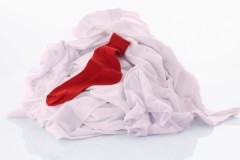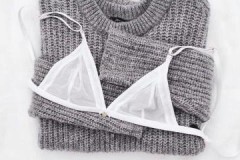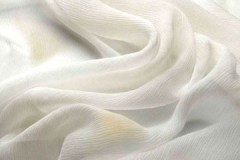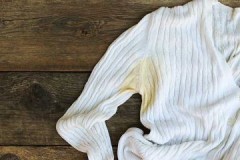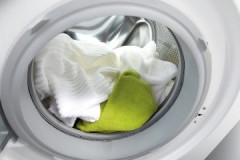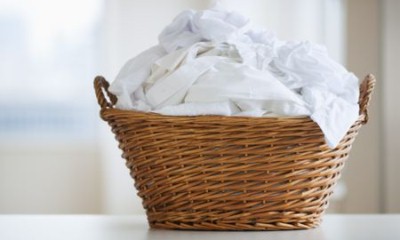 White things look smart even without additional accessories. For such clothes to be always beautiful and clean, proper care is necessary for them.
White things look smart even without additional accessories. For such clothes to be always beautiful and clean, proper care is necessary for them.
It must include proper washing, stain removal, bleaching and proper drying.
How to wash white things in an automatic washing machine and by hand, with what you can and cannot, how to bleach correctly so that the linen is snow-white, we will tell in the article.
Content
- Preparing to wash: what does the label tell you about?
- How to wash in an automatic washing machine: at what temperature, at what mode?
- How to hand wash correctly?
- Removing stains at home
- What if the thing gets dyed?
- The Best Whitening Techniques to Keep Lingerie White
- Drying: where and how?
- Recommendations
- Related Videos
- Conclusion
Preparing to wash: what does the label tell you about?
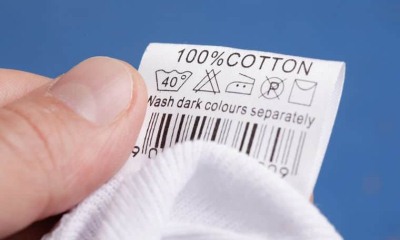 Washing clothes of any color, and even more so white, should begin with studying the label for the product.
Washing clothes of any color, and even more so white, should begin with studying the label for the product.
The manufacturer indicates on it all the nuances of processing:
- possible type of washing;
- permission or prohibition to conduct dry cleaning;
- the possibility of ironing and in what mode, at how many degrees to carry it out, as well as other useful information.
Some white items can be washed in hot water and bleached. This group mainly includes clothes made of dense natural cotton.
Without studying the useful information from the label, you cannot start washing - you can irrevocably spoil the thing. In addition to studying information from the manufacturer, before washing, you must inspect the thing for defects:
- line torn along the seam;
- poorly fastened buttons;
- stains, etc.
It is necessary to eliminate them before the main wash, regardless of whether it will be carried out by hand or in the washing machine. Next, things should be sorted by color and washing criteria.
You can find out if it is possible to wash white with color here... Is it possible to wash together white and gray, read here.
How to wash in an automatic washing machine: at what temperature, at what mode?
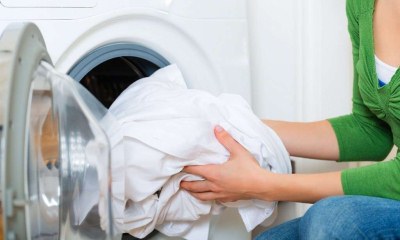 Handling things in a washing machine is convenient, time-saving and effortless.
Handling things in a washing machine is convenient, time-saving and effortless.
But it is possible to put into the drum only those products that meet two main requirements:
- The manufacturer allows them to be washed in this way.
- The preparation for washing is completed, the defects, if any, have been eliminated.
Generally accepted recommendations for washing white clothes are presented below:
| Product type | Fabric type | Washing temperature, ºС | Mode |
| Shirt, pants, skirt, dress, etc. | Silk | 30 | Silk, Delicate |
| Cotton | 40 | Cotton, Delicate | |
| Synthetics | Synthetics | ||
| Underwear | Synthetics or cotton | Up to 40 | Delicate |
| Sweater, pullover, golf, etc. | Wool | 30 | Wool, Delicate |
| Underwear | Cotton | 60, if very dirty - 90 | Cotton |
| Linens | |||
| Waffle towels | |||
| Kitchen towels | |||
| Terry towels | 40 to 60 | ||
| Diaper | Up to 95 | Baby clothes, Boiling |
It is recommended to select a detergent marked "White" or "for white items". These preparations contain bleaching agents that will not damage the fabric. These products are available in powder and gel form.
Washing procedure:
- Load the previously inspected and sorted products into the machine.
- Add detergent to the special compartment, which is intended for washing white items.
- A fabric softener can be added to a separate compartment (except for delicate items that can be washed without it).
- Set the mode on the typewriter. If necessary, adjust the temperature.
- Start the washing process.
If things are very dirty or worn out, they must be soaked beforehand. This can be done in a basin, or by setting a separate mode (if any) on the washing machine.
The soaking time directly depends on the material and the product itself... Maximum, up to 4 hours, is allowed for cotton towels and bed linen. For delicate fabrics - up to half an hour.
If the white fabric has a yellowish tinge due to wear, then oxygen bleach can be added to the powder container when washing in the machine.
How to hand wash correctly?
For hand washing, prepare a large basin and detergent.
Procedure:
- Fill a basin with water at a temperature suitable for washing.
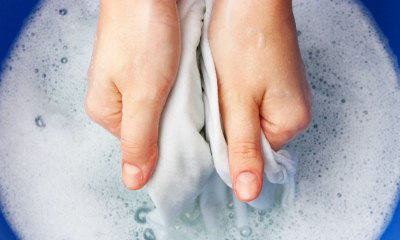 Dilute the detergent.
Dilute the detergent.- If necessary, especially stained areas can be lathered with laundry soap.
- Soak things. This will make it easier to wipe off dirt later. The soak time can be from 15-30 minutes for delicate clothes and up to 4 hours for cotton bed linen and waffle towels.
- If after soaking the water becomes dirty, it must be replaced and the detergent or gel must be dissolved in it again.
- Hand wash. Stained areas will be easier to clean if you rub them gently with a brush.
- Rinse things out by changing the water.
Removing stains at home
Spots can completely ruin the whole effect of a white thing. It is advisable to start removing them as early as possible so that the impurities do not have time to soak deep into the fibers.
You can learn about ways to remove yellow spots of various origins from white things from this articles.
Fat
You can try to remove a greasy stain in several ways.... One is applying dishwashing detergent to the fabric. If you have white chalk on hand, you can crush it and sprinkle on a greasy stain. The white powder will absorb the fat particles.
Grass
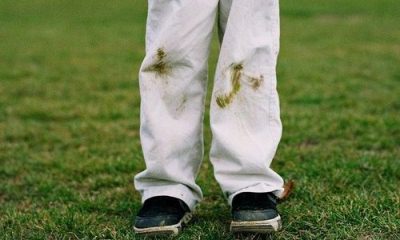 Treatment with alcohol will help remove the trail of grass from the surface of the white material. If it is not available, you can use vodka.
Treatment with alcohol will help remove the trail of grass from the surface of the white material. If it is not available, you can use vodka.
Procedure:
- the stained area is impregnated with an alcohol-containing liquid;
- leave the thing for a quarter of an hour;
- rinse;
- wash.
To remove stains from white clothes, it is allowed to use only alcohol and vodka, as other alcohol-containing drinks can stain the fabric.
Fruit
Berry and Fruit Spots - Difficult enough to remove... If possible, the item should be washed immediately using washing powder. After the stain has been treated, the soiled clothes are soaked for half an hour and washed in the usual way.
Blood and wine
Treating wine or blood stains with rubbing alcohol or hydrogen peroxide. After the active ingredient has worked, the product is rinsed and washed.
Read about how to remove traces of red wine from white clothes. here.
Sweat
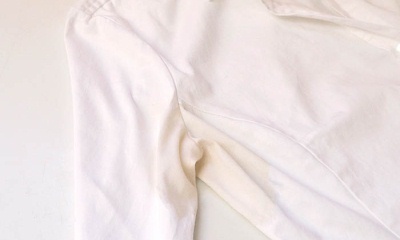 There are several ways to remove sweat stains. You can do the following:
There are several ways to remove sweat stains. You can do the following:
- Combine 1 tbsp in a bowl. soda and 1 tbsp. l. salt.
- Add 1 tsp. liquid soap.
- Stir.
- Apply to stains.
- Withstand half an hour.
- Wash.
In addition, sweat stains can be removed in ways that are not available for colored fabrics due to possible discoloration. Such agents include hydrogen peroxide.
As a quick response method, this recipe will help:
- pour peroxide directly from the bottle onto the spots;
- withstand a quarter of an hour;
- wash.
Effective ways of how and how to remove yellow spots from sweat under the armpits from white clothes are presented here.
Nail polish and paint
You can try to remove stubborn stains with suitable solvents. For varnish - varnish remover, for paints - White spirit or another solvent.
What if the thing gets dyed?
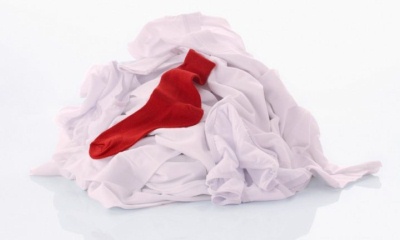 If, with white items, not only white, but also colored items get into the same load of the washing machine or into the basin, the items can be seriously damaged.
If, with white items, not only white, but also colored items get into the same load of the washing machine or into the basin, the items can be seriously damaged.
Even the joint processing of white clothes and having a light tone often leads to irreparable consequences. If a staining problem is identified, you need to fix the situation very quickly, until the spots are old.
A white thing can become stained not only during the washing process, but even with improper drying close to colored clothes. How to deal with the problem of accidentally dyeing a white thing, you can learn here and here.
The Best Whitening Techniques to Keep Lingerie White
To restore snow-white things, you can use several methods to solve the problem:
- the use of folk recipes;
- the use of bleaching agents for household chemicals;
- boiling.
Each bleaching method has limitations, which must be taken into account.so as not to spoil the product.
Boiling
The use of boiling allows not only to whiten things, but also to remove dirt, and also to refresh the fabric. It may be allowed to expose to such an effect only products made of thick cotton or linen fabrics that do not have complex cuts, decor and inserts from other materials.
For boiling you will need:
- large enamelled container (about 10 liters in volume);
- detergent (laundry soap - 1-2 pieces);
- device for mixing things.
It is not advisable to use galvanized and aluminum pots for digestion, since as a result of the chemical reaction of the detergent with the metal, stubborn stains can appear on the fabric.
Also, do not replace laundry soap with washing powder during washing - during the boiling process, vapors harmful to humans will enter the air. In addition, most washing powders are not designed for heating above + 95 ° C.
Procedure:
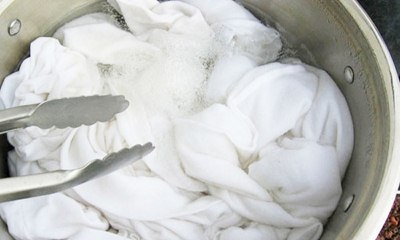 Grate with laundry soap.
Grate with laundry soap.- Collect water in a container.
- Put the container on fire.
- Pour in the grated soap.
- Stir to achieve complete dissolution.
- Place the laundry in water.
- Bring the washing solution to a boil, stirring occasionally.
- Reduce fire.
- Continuing to stir things, boil them for 1-1.5 hours.
- Leave things to cool.
- After washing, rinse and dry.
To enhance the effectiveness of boiling, you can add 2 tbsp. l. hydrogen peroxide. An alternative option is the addition of 10 Art. l. soda.
Use of household chemicals
In addition to bleaches containing chlorine, modern housewives have in their arsenal products that act gently without damaging the fabric. They can be used for washing, and can also be added to detergent powder as a supplement to increase washing efficiency.
These bleaches include:
- "Vanish";
- "BOS plus" and others.
Regular use of bleach will keep your garments whiter.
Folk recipes
A simple way will help to make bed linens and T-shirts whiteness - adding 1 tbsp. l. soda in the washing powder compartment of the machine. You can also add baking soda to powder and manual processing.
Soaking in a solution with ammonia will also help to whiten things:
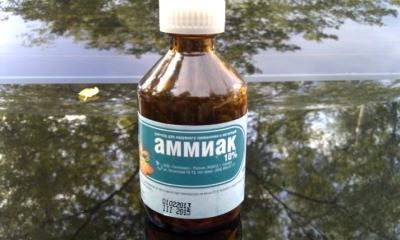 Combine 2 tbsp in a bowl. l. ammonia and the same amount of soda.
Combine 2 tbsp in a bowl. l. ammonia and the same amount of soda.- Mix.
- Pour into a basin.
- Fill with water (5 l.).
- Mix.
- Dip the laundry into the basin.
- Leave for a couple of hours.
- Rinse.
- Wash normally.
Drying: where and how?
It is necessary to dry white things immediately after washing, without leaving them for a long time in the drum of the machine or in the basin, since things can at the same time acquire an unpleasant odor and go with stains and smudges. The clothes are wrung out from excess water and dried in a straightened form.
How exactly to dry a thing depends on its type and material:
- woolen sweaters - in a horizontal position on a terry towel;
- linen and bedding - by throwing it over the clothesline;
- blouses and shirts - on a trempel;
- T-shirts - on a rope, using clothespins.
To speed up the drying process, white clothes should not be placed on heating appliances or near an open flame. Clothes dry best outdoors and in dry rooms.
It is necessary to provide them with the opportunity to dry in a straightened form, without touching walls and other clothing. Before hanging white items on a drying line outside, make sure it is clean.
Recommendations
Wash white clothes without unpleasant consequences the following tips will help:
 It is advisable to wash white items separately from items of other shades.
It is advisable to wash white items separately from items of other shades.- It is necessary to fight stains on clothes before the main wash.
- It is more difficult to wash worn-out light-colored clothes than those that have been worn 1-2 times.
- When boiling laundry, it is necessary to turn on the hood or open a window.
- It is recommended to wash things as they become dirty, without accumulating them for a long time.
- White items should not be stored in direct sunlight.
- Removing stains from clothes and hand washing should be carried out with rubber gloves.
- Spinning at high speeds leads to rapid wear of things.
For expensive exclusive items, dry cleaning can be used.
Related Videos
How to wash white clothes, video recommendations:
Conclusion
It will not be difficult to maintain the whiteness of things if you wash them regularly, not allowing the stains to get old and the product itself to wear off. Additionally, you should follow all the rules for caring for products, including proper drying and storage.
